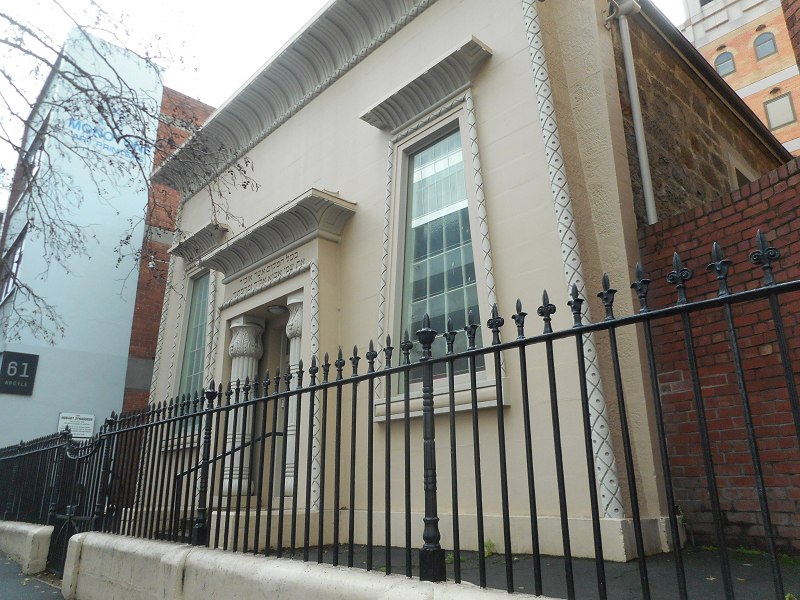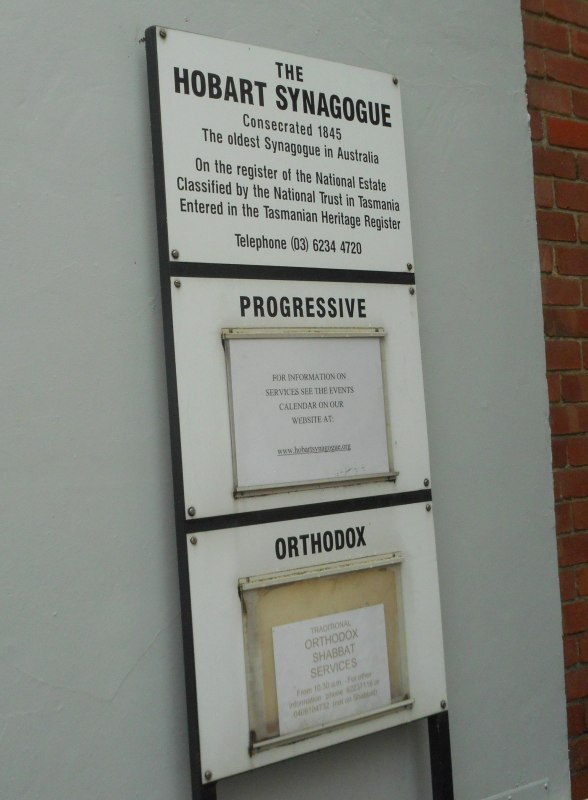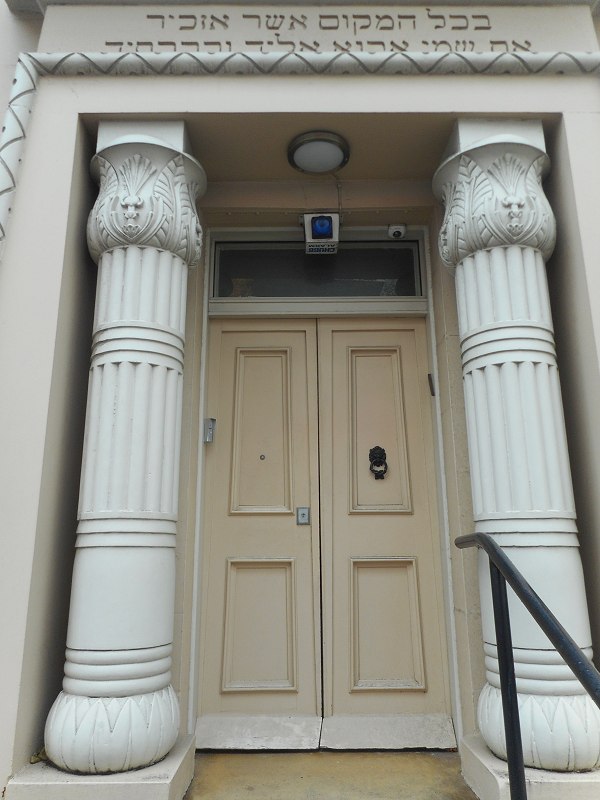57 Argyle St, Hobart. Google Maps.
Opened 1845.
Photos 1961: Interior & Exterior
Map, block bounded by Bathurst, Campbell, Liverpool and Argyle Streets
THE JEWS.-We understand that Mr. Judah Solomon has presented the Hebrew congregation here with that fine piece of land adjoining the Temple House, in Argyle-street, for the erection of a synagogue. Upwards of £400 is, we believe, already subscribed towards the erection of the building.
Launceston Examiner, 26 April 1843
JEWISH SYNAGOGUE.
These industrious and persevering people have resolved to provide them-selves with a House of Worship. Mr. Judah Solomon has made a gift of a piece of ground whereunto build the Synagogue, and there is above £600 already subscribed towards its erection. An opportunity is now given to Christians to return the frequent liberality of the Jews towards the erection of Christian churches.
Colonial Times, 2 May 1843
CEREMONY.-The Foundation Stone of the new Synagogue will be laid to-morrow afternoon, at two o’clock.
Colonial Times, 8 August 1843
LAYING THE FOUNDATION-STONE OF THE JEWISH SYNAGOGUE.
The first stone of the Synagogue, about to be erected in Argyle-street in this City, for the worship of Jehovah by the descendants of the people of Israel, was laid on Wednesday. The event attracted a large attendance of citizens, including nearly every Jew resident in this part of the colony. At two o’clock, the appointed hour, the Committee of Management assembled at the residence of Judah Solomon, Esq., and soon after proceeded to the ground, headed by Louis Nathan, Esq., President, and attended by Phineas Moss, Esq , Secretary, Samuel Moses, Esq., D. R. Furtado, Esq., Mr. D. Moses, James Thompson, Esq., Architect, and other gentlemen, with plans of the intended building, a silver trowel, a square, plumb, mallet, &c., to be used in the ceremony, and a sealed bottle, in which was enclosed a record, on parchment, in the Hebrew language, with an English translation, also the names of the subscribers to the fund, and other particulars of the building.
All being in readiness, Louis Nathan, Esq., deposited the bottle in the cavity which was prepared for its reception, and read, in both languages, the following copy of the record :
“On the fourth day of the week, the thirteenth day of the month Ab, in the year five thousand six hundred and three from the foundation of the world, and the seventh year of the reign of Queen Victoria, the first stone of this House of Assembly, dedicated to the name of the Lord God of Israel, was laid by Louis Nathan, Esq , in the presence of the congregation, in the city of Hobart Town, on this portion of ground, given as a perpetual gift by Judah Solomon, Esq.”
[continued]
The Courier, 11 August 1843
JEWS’ SYNAGOGUE.-This simple but elegant building is advancing fast towards completion under the active superintendence of Messrs. Kirk and Fisher, the well-known builders of our city. The plans, &c, are from the classical designs of Mr. J. A. Thomson, who has with great propriety and adaptation adopted the Egyptian style for the architecture of the temple, which, in all but its imposing vastness (which would be here out of place) Mr. Thomson has accurately followed. The front, with all, but the superincumbent coping, is now finished, and the carving of the pillars on each side of the doorway, as well as of the sides and architraves of the windows is finished off in a style of chaste beauty which we did not think any one in this colony was capable of executing. This part of the work, it will surprise some people to learn, has been done by Mr. Fisher himself, although properly speaking, the province of an accomplished carver ; and it affords an illustration of the origin of ornamental architecture deriving its birth from the splendid architecture of nature, as evident in the magnificent and luxuriant trees of the eastern forests. To the Egyptian pillar there is properly no pediment, the base rising, as it were, out of the parent earth, and then expanding into abroad leaf, enclosing or rather clasping the capital. In miniature, the Synagogue is an Egyptian temple of the great and palmy days of the Pharaohs, such as enhanced the gorgeous architecture of those palace cities of Tyre and Sidon, of Babylon and Memphis, and Thebes now all laid in the dust a sad, but monitory example of the mutability of all earthly things ; And when the interior is completed, it will present a specimen of colonial architecture at present unrivalled. When this takes place, we shall give a more full and detailed description of the building, which promises to prove highly creditable, not only to its originators, but to all engaged in its erection, and, above all, as affording to the “ancient people” a befitting temple for the worship of the true God, in the purity and holiness of the ancient faith.
Colonial Times, 28 November 1843
The Jews’ Synagogue.
The front elevation of the Temple in Argyle-street, designed for the worship of Jehovah by the remnant of the children of Israel in this city, is now completed, and elicits universal admiration. It is of the highly ornamented Egyptian style, and presents a front of elaborately carved stone-work, whether we regard the beauty of the design or the labours of the chisel, perfectly unique in the colony. The cornice is a fine specimen of workmanship, and it is to be wished that an erection so really beautiful had occupied a site more commanding, and apart from the vicinity of the buildings by which it is surrounded, it would then have been viewed to much better advantage ; but when the rubbish is cleared from the front, the palisading erected, and the windows glazed, it will present an object of attraction amongst our city buildings. The blocks, quarried from the fine free-stone in the Government Paddock, are of a uniform colour, dressed to a fine smoothness, and admirably adapted for carving ; it is also of a very durable character, becoming more hard by exposure. Over the front entrance the following text, from Exodus, 20th chapter, 24th verse, is beautifully engraved in the Hebrew language :”In all places where I record my name, I will come unto thee, and I will bless thee.” The carved work is principally from the chisel of Mr. Fisher, of the firm of Kirk and Fisher, the contractors. The roof and the window frames, we learn, are in a state of forwardness. The interior comprises an area of 60 feet by 30, in which will be erected a spacious gallery and school-room. The foundation stone was laid on the 9th August last.-(Hobart Town Advertiser)
The Courier, 2 February 1844
JEWS’ SYNAGOGUE.-We understand that the New Synagogue, Argyle-street, will be opened for Divine Service in about five weeks ; the interior, which is being fitted up under the superintendence of Mr. J. A. Thomson, the architect of the building, exhibits much taste and elegance. The chandeliers, of which there are to be five large ones, with the other branch lights, are about to be manufactured in the colony ; they are of a very handsome pattern, and strictly in accordance with the rest of the edifice : much interest is excited in reference to the opening, when several ancient melodies, peculiar to the Hebrew nation, will be sung by the choir. Upon this occasion visitors will be admitted by tickets only.
The Courier, 17 April 1845
To the Editor of the Colonial Times.
Oatlands, May 16, 1845.
” Bekol-haramnwgom asher azkir eth-shemi awbo aleika uberaktika.”
” In all places where I record my name, I will come unto thee and bless thee.”
Exodus, chap. xx, ver. 24.
Sir,-This I believe is the inscription, in Hebrew characters, upon the new Synagogue, and I have given it as above in the English character, so that some further attention may be drawn to the inscription itself.
In turning the sentence over in my mind in a walk the other day, I find such scope and expression in the original, that, without sermonizing in your journal, I perhaps may elucidate the passage. The depth, and if I may so ex-press it, the sentiment of the quotation in the Hebrew language is so far greater than the translation, that perhaps, Sir, you will pardon me for troubling you with this critique upon it.
Bekol-hammawgom, literally means, in the whole of, or in all of the place, translated in our Bible, in all places. Here the Omnipresence of the Deity is clearly enunciated, in all places, i.e. throughout all space, illimitable, the Spirit of God exists and energizes, even to the extreme portions of the earth again. Asher azkir eth-shemi, where I shall bring to remembrance my name, azkir being in the Hiphil form of the verb zakar, makes it causative, for in the 39th Psalm the superscription is, A Psalm of David. Lehazkir, i.e. to bring one’s self into remembrance with God. So here we find that the promise of God’s omnipresent Spirit was not only vouchsafed to those desirous of communing, but that there should be a more than searching after it, as the verb denotes–a reciprocal effect, a causation—therefore God will here by his promise cause those who are desirous to have His name in remembrance, to have the record of it imprinted vividly in their hearts ; and this is proved by the verb awbo I will come in, or go, or enter in,–aleika, unto thee, which signifies a participating activity in action, even as far as the heart that worships and yearns after that warmth which Holy communion with the Deity can alone inspire. Uberaktika, and I will bless thee ; this is the Piel form of the verb bawrak, meaning in some forms to bend the knee, as it does in Arabic and Syriac ; not only does Jehovah here promise His blessing, but He also promises to make happy and to prosper, as by a metonymy of the cause for the effect. Here the prophetic sentence gives as much as any mortal can desire or deserve ; it promises that in every imaginable spot, however remote, where His name (i. e. presence) shall be vouchsafed, THERE He (the Holy One–blessed be He,) WILL come, and in coming will bless thee.
Quch na benei-ytzrael edi minchat todah asher hâbawti aleikem mi ebedteka.
GREGORY BATEMAN, M.A.
Colonial Times, 17 May 1845
THE HEBREWS.
The Synagogue, certainly the handsomest little edifice in all Australia, which Mr. Thomson, the architect, and all the gentlemen concerned in its erection, deserve the highest praise for, will be opened we learn next week. Those families who are desirous of witnessing the interesting spectacle, and hearing beautiful music, had better apply for tickets without delay. The Chief Rabbi in England, Dr. Nathan Adler, will no doubt soon send out an officiating minister here. That reverend gentleman, who has been Chief Priest of Hanover since 1832, was elected in preference to Dr Auerbach, who has been Chief Rabbi of Darmstadt for ten years ; Dr. Airschfieild, who has been for a short time Chief Rabbi of Woolstein; and Dr. Sampson Hirsch, who has been Chief Rabbi of Oldenburgh since 1831, and is at present the Chief Rabbi of East Friesland. The whole of these reverend gentlemen are celebrated on the continent in the Christian and Jewish circles for their piety and attainments, the three first being doctors of philosophy of eminent foreign universities. Dr. Adler, possesses high testimonials and recommendations from the late and present Government of Hanover.-Review.
Colonial Times, 17 May 1845
THE SYNAGOGUE.-The unique little edifice exhibiting in its exterior embellishments and architecture the peculiar characteristic of the Egyptian style, which has been erected in Argyle-street by the members of the Hebrew persuasion for a Synagogue, will, it is understood, be opened for consecration and Divine worship on Friday, the 4th July; Upon this event a form of service composed for the occasion, in Hebrew and English, will be used, in addition to the ordinary evening and Sabbath eve services. During the consecration ceremony several ancient melodies, peculiar to the Hebrew nation and used by the Jews from time immemorial, will be introduced. From the limited extent of the building no person can be admitted who is unprovided with a ticket The committee have, with great liberality, erected two temporary galleries for the accommodation of ladies who may desire to be present at the opening of the Synagogue. It will not be amiss to observe that it is customary in a Synagogue for the sexes to sit apart. The women occupy the gallery, the men the ground floor, and with their hats on.
The Courier, 17 June 1845
SYNAGOGUES AND SYNAGOGUE WORSHIP.
As the day for the opening of the Jewish Synagogue in Argyle-street is approaching, we think the following account of Synagogues and Synagogue Worship on the authority of the learned Calmet, may not be unacceptable to the generality of our intelligent readers.
The word Synagogue primarily signifies assembly ; but like our word Church, came at length to be applied to places in which assemblies for the worship of God were convened. They do not appear to have been in use until after the Babylonish captivity, prior to which meetings for religious worship seem to have been held either in the open air or in the houses of the prophets.
[continued]
The Observer, 27 June 1845
OPENING OF THE SYNAGOGUE IN ARGYLE STREET.
THE beautiful little building in Argyle-street devoted to religious service by the scattered remnant of Israel in this town, was opened according to announcement, on Friday last. Every seat was occupied, and the doors closed punctually at three o’clock. At first, the eye of the stranger was naturally drawn to the crowded splendour of the internal arrangements.—The elevated and carpeted space railed in the centre, and allotted to the reading desk and choir, the elegantly embroidered velvet curtain covering the ark the pillars of carved work with their gilded capitals, corresponding with the Egyptian style of the building, the gorgeous chandeliers (wholly of colonial manufacture), the singular appearance of males only, with covered heads in the area, while the ladies occupying the gallery, were, generally without bonnets ; these things for a moment or two divided the attention, but thoughts and feelings of deeper interest soon crowded upon us.
[continued]
The Observer, 8 July 1845
OPENING AND DEDICATION OF THE JEWS’ SYNAGOGUE.
ON Friday last, the 4th instant, this elegant little building, which has recently been built in Argyle-street, was opened to the public. Visitors were admitted by tickets liberally furnished by the Committee. The ceremony of the Dedication of the building commenced shortly after three o’clock p.m., before which time the building was literally crowded.
An introductory symphony of Haydn’s having been played, the Officers of the Congregation, consisting of the President, Louis Nathan, Esq. ; the Treasurer, Judah Solomon, Esq. ; and Messrs. D. Moses, D. Heckscher, B. Hart, J. Friedman, P. Levy, J. Solomon, and the Secretary, Phineas Moss, Esq., brought the Bolls of Law from the Vestry to the door of the Synagogue, where, three knocks having been given, they called:
Open unto us the gates of righteousness ; we will enter them and praise the Lord.
The doors were then opened, the procession of officers entered standing beneath a canopy, while the Choir chaunted:
How goodly are thy tents, O Jacob! thy tabernacles, O Israel !
O Lord ! I have ever loved the habitation of thine house, and the dwelling-place of thy glory.
We will come unto thy tabernacles, and worship at thy foot-stool.
[continued]
The Courier, 9 July 1845



